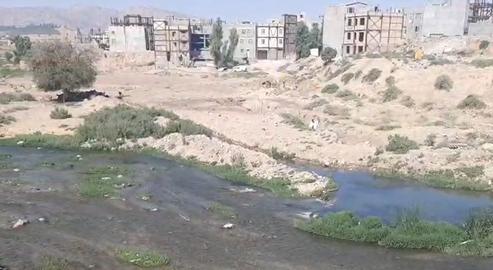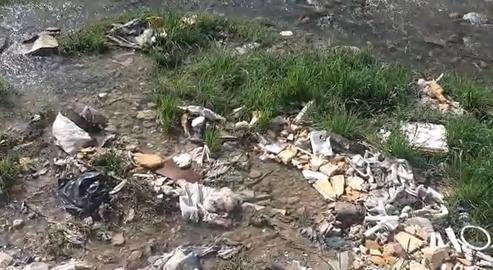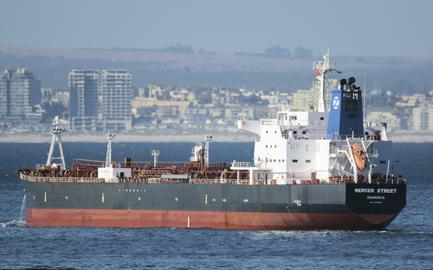In recent weeks, protests over the water crisis in Khuzestan and the Iranian state’s bloody crackdown on dissent have dominated the news. But Khuzestan is far from the only region facing severe and potentially disastrous droughts.
Kermanshah, also in western Iran, is in similarly dire straits. On Monday, July 26, a number of citizens in the provincial capital blocked streets leading to the neighborhood of Mehdieh to demonstrate against both water shortages and frequent power outages.
The regime’s handling of the unrest was no different: human rights organizations report that at least 20 people were arrested for taking part in the small protest.
Many of Kermanshah’s rivers, wetlands and larger inland water sources have met the same fate as those of Khuzestan; they have either dried up and permanently subsided, or else are in a critical state.
On Tuesday, July 20, the Revolutionary Guards-affiliated Tasnim news agency reported that the river Razavar in Kermanshah province was running dry. On the same day Mohammad Hossein Falahati, head of Kermanshah’s Environmental Protection Department, warned that that Hashilan Wetland was at risk of drying up in the next 20 days.
Meanwhile Alireza Kakavand, head of Kermanshah Water and Sewage Company, has said that in response to drought, low rainfall and water shortages in parts of Kermanshah city, four deep wells had been drilled as an “emergency response”. Six others, he said, would be established over the next six weeks.
Expert View: Drilling Wells in Kermanshah Will Worsen Iran’s Water Crisis
Dr. Mansour Sohrabi, an agro-ecologist based in Germany, told IranWire that aside from the chronic mismanagement of water resources in Iran, factors such as lopsided agro-industrial development, insufficient rainfall, the reckless and haphazard construction of dams and the diversion of at least 45 percent of Kermanshah’s groundwater to Iraq have played a decisive role in the present crisis.
The decision to drill new wells, he said, was clearly a “hasty” one. Kermanshah currently has a shortage of 1.1 billion cubic meters of water in its aquifers – underground layers of water-bearing permeable rock – which has been caused by disorderly drawing of water from underground by the state, businesses and ordinary citizens.
“Drilling wells to supply water in Kermanshah province is an ongoing strategy,” he said. “It’s a horrible strategy. It has turned the important plains of Ravansar-Sanjabi and Hasan Abad of Qaleh-ye Myan into critically prohibited plains. Absolutely no water should be extracted from the aquifers, and agriculture in this area must stop, until the natural balance is restored.”
In Iranian government parlance, a “prohibited plain” is an area in which the level of underground water is low enough that no new wells should be drilled. “Critically prohibited plains” are those where any further drawing of water creates a serious risk of subsidence. Permits to draw water in these zones are issued on a case-by-case basis.
Countdown to an Environmental Disaster
Sohrabi believes government officials in Kermanshah are well aware of the fragility of water resources in this province. Through “emergency” actions such as these, he says, they are pushing Kermanshah toward outright environmental disaster.
There are currently 11 prohibited plains in Kermanshah, including around the capital. To drill new wells is to trigger a process that could lead to a new water “super-crisis”: “By continuing to drill wells,” Sohrabi said, “they are driving other prohibited plains toward become critically prohibited too. The plains of Kangavar, Sonqor, Miyan Rahan, Sahneh, Kermanshah, Mahi Dasht, Eslam Abad, Kerend-e Gharb, Sarpol Zahab and Zahab will meet the same fate as Ravansar-Sanjabi and Hasan Abad.”
Decades of dam-building projects in Iran to control and divert water have failed to achieve their aims, while the main drainage basin in Kermanshah, where precipitation collects and drains off into common outlets such as rivers, has been partly cut off.
A resident of the city of Paveh told IranWire the nine-year construction of the Daryan Dam on the Sirvan River, which completed in 2018 has had a shocking impact on water resources even in Paveh itself. The rural districts of Bayangan, Hajij and Uraman and even the famous Bil Spring, the biggest spring in western parts of Iran, have also been severely affected.
“When the Daryan Dam was under construction,” they said, “I witnessed with my own eyes that they were drilling holes in scores of places, destroying several mountains in the area with horrifying and repeated explosions.
“The digging of the Hirwi Water Tunnel to Dasht-e Zahab not only disrupted water supply in the region but also led to wildfires in dried-up oak forests. Since the dam’s construction, the rate of wildfires is incomparable to how it was before. Every oak tree in these forests adds 250 liters of water a year to the underground reservoirs.”
The mountainsides of Dalahu, the plains of Dasht-e Zahab and Nava-Kuh, and the villages of Sarab-e Qaleh Shahin and Direh in Sarpol Zahab, all used to be fertile and teeming with life. Now, though, farmers and households are faced with a dire shortage of drinking water and inability to irrigate their crops and orchards.
The water crisis in this region is growing worse by the day. The town of Sarpol Zahab is normally serviced by the well-known Alvand River as well as the smaller rivers of Daleh Shir and Seyed Sadegh, and springheads including Qarah Bolagh, Qaleh Shahin, Garm and Dasht-e Direh. Most of these go on to pass through the city of Qasr-e Shirin on the western border before reaching Khanaqin in Iraq. But Qaleh Shahin and Dasht-e Direh have now shrunk to 30 percent of their former volume, while the Alvand and Daleh Shir rivers are down to 10 percent of the former supply. They cannot support the local population anymore, let alone others further downstream.
From Symbol of Life to Garbage Dump
A resident of Sarpol Zahab, who also happens to be a lover of literature and music, wistfully told IranWire that the Alvand River was once a magnificent symbol of life and fertility for the region’s poets and writers.
But now, they said, “it has turned into a foul-smelling ribbon of water – and a garbage dump that breeds respiratory and skin diseases, and all kinds of insect.”
An environmental activist in Sarpol Zahab added: “We’ve repeatedly warned officials about the pollution resulting from the drying-up of Alvand River. But unfortunately they did not, and would not, listen.”
They added that the shrinkage of Kermanshah’s rivers has also caused skirmishes between local farmers and orchard owners, who fight over the remaining water. “One quarrel over water allocation recently led to a bloody fight in western Kermanshah between the Jaff tribe [Kurdish Sunni Muslims] and the Ghalkhani tribe [Kurdish followers of Yarsanism].” At least three people were reportedly killed in the fray, and tensions continue now.
On June 30, Tasnim news agency claimed that at least 130 villages in Kermanshah were being supplied by water tankers during the hot summer months.
But a municipal worker who instals water pumps in Salas-e Babajani was incredulous about the claim: “These days, lots of people in Sarpol Zahab, Salas-e Babajani and Qasr-e Shirin are being forced to use water pumps to get by,” he said.
A Sarpol Zahab resident, who works at an orchard in nearby Dasht-e Zahab, told IranWire that orchards across Kermanshah are now under-irrigated and people in the villages of Rizhav and Zardeh often have no drinking water at all.
The Qarah Bolagh springhead was in a better situation than others, he said, but in many villages downstream its water is no longer safe and has to be purified first. “About 15 villages are now sometimes going without drinking water for five days straight,” he said. “The government has shrugged off its responsibility to provide them with water.”
Related Coverage:
Iran's Water Crisis: Where to Begin?
Football Fans' Celebrations Turn Into Anti-Government Protests
More Arrests as Protests Intensify in Cities Across Iran
Desertification in Iran: A Ticking Time Bomb?
Iran's Water Crisis: In 20 Years Drought Could Make Some Iranian Cities Uninhabitable
Anti-Government Protests Erupt in Tehran
Iran Protests: Grenade Launchers and Shotguns Used on Protesters
Solidarity With Khuzestan Water Protests Spills Into Other Iranian Provinces
Iranians Rally in Support on Fifth Night of Khuzestan Water Protests
visit the accountability section
In this section of Iran Wire, you can contact the officials and launch your campaign for various problems


























comments